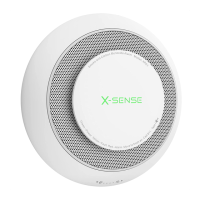01 02
This user manual contains important information about your combination smoke &
carbon monoxide alarm’s operation. To ensure proper use and trouble-free operation,
please read this manual carefully and store it in a safe place for future reference.
Introduction
All X-Sense combination smoke & carbon monoxide alarms conform with regulatory requirements,
including UL 217 & UL 2034 standards and are designed to detect both smoke and carbon monoxide.
This unit adopts photoelectric technology to detect smoke which is generally more sensitive than
ionization technology. It is eff ective at detecting large particles, which tend to be produced in greater
amounts by smoldering fi res and may smolder for hours before bursting into fl ame. Sources of these
fi res may include cigarettes burning in couches or bedding.
Carbon monoxide (CO) is odorless, tasteless and invisible - it’s a silent killer. Using electrochemical
sensing technology, this unit can detect increased levels of carbon monoxide early, protecting your
family from the dangers of carbon monoxide.
• The installation of the apparatus should not be used as a substitute for proper installation, use and
maintenance of fuel-burning appliances including appropriate
ventilation and exhaust systems.
• This apparatus is to be installed by a competent person.
• It is not tested for use in a caravan or boat.
Note: For maximum protection, use smoke & CO alarms on each level and in every bedroom of your
home.
NEVER IGNORE THE SOUND OF THE ALARM!
Determining what type of alarm has sounded is easy with your X-Sense combination smoke & carbon
monoxide alarm. The alarm sounder will inform you of the type of situation occurring.
When the Smoke Alarm Sounds:
Smoke alarms are designed to minimize false alarms. Cigarette smoke will not normally set off the
alarm, unless the smoke is blown directly into the alarm. This unit contains nuisance alarm protection,
which will reduce the impact of cooking particles. However, large quantities of combustible particles
from spills or broiling could still cause the unit to alarm. Careful location of the unit away from the
kitchen area will give the maximum nuisance alarm protection. Combustion particles from cooking
may set off the alarm if located too close to the cooking area. Large quantities of combustible particles
are generated from spills or when broiling. Using the fan on a range hood which vents to the outside
(non-recirculating type) will also help remove these combustible products from the kitchen. If the alarm
sounds, check for fi res fi rst. If a fi re is discovered, follow these steps. Become thoroughly familiar with
these items, and review with all family members!
* Alert small children in the home. Children sleep very sound and may not be awakened by the sound
of the smoke alarms.
* Leave immediately using one of your planned escape routes. Every second counts, so don’t stop to
get dressed or pick up valuables.
* Before opening inside doors, look for smoke seeping in around the edges, and feel with the back of
your hand. If the door is hot, use your second exit. If you feel it’s safe, open the door very slowly and
be prepared to close immediately if smoke and heat rush in.
* If the escape route requires you to go through smoke, crawl low under the smoke where the air is
clearer.
* Go to your predetermined meeting place. When two people have arrived, one should leave to call
emergency service from a neighbor’s home, and the other should stay to perform a head count.
* Do not reenter under any circumstance until fi re offi cials give the go-ahead.
* There are situations where a smoke alarm may not be eff ective to protect against fi re. For instance:
•
Smoking in bed.
•
Leaving children unsupervised.
•
Cleaning with fl ammable liquids, such as gasoline.
•
Fires where the victim is intimate with a fl aming initiated fi re; for example, when a person’s clothes
catch fi re while cooking.
•
Fires where the smoke is prevented from reaching the detector due to a closed door or other
obstruction.

